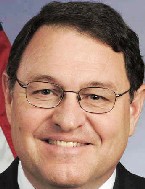NTIA Announces Plan to Reallocate 115 MHz of
Spectrum
November 15, 2010. The National Telecommunications and Information Administration (NTIA) released a report [262 pages in PDF] that announces plans to reallocate 115 MHz of spectrum currently used by federal agencies for wireless broadband "in the next five years".
Both President Obama and the Federal Communications Commission (FCC) have called for reallocating 500 MHz of spectrum.
 Lawrence
Strickling (at right), head of the Department of Commerce's (DOC) NTIA, stated
in a
release that this report "sets forth a bold vision for spurring innovation
and preserving America's technology leadership by expanding the amount of
spectrum available for wireless broadband. Today's announcement is a significant
down payment towards realizing that goal. NTIA will continue to work with the
FCC and other U.S. agencies to make the full 500 megahertz of spectrum available
while protecting vital government uses".
Lawrence
Strickling (at right), head of the Department of Commerce's (DOC) NTIA, stated
in a
release that this report "sets forth a bold vision for spurring innovation
and preserving America's technology leadership by expanding the amount of
spectrum available for wireless broadband. Today's announcement is a significant
down payment towards realizing that goal. NTIA will continue to work with the
FCC and other U.S. agencies to make the full 500 megahertz of spectrum available
while protecting vital government uses".
This report is titled "An Assessment of the Near-Term Viability of Accommodating Wireless Broadband Systems in the 1675-1710 MHz, 1755-1780 MHz, 3500-3650 MHz, and 4200-4220 MHz, 4380-4400 MHz Bands".
It states that the "four candidate bands considered by NTIA in the Fast Track Evaluation are: (1) 1675-1710 MHz, (2) 3500-3650 MHz, (3) 4200-4220 MHz and 4380-4400 MHz, and (4) 1755-1780 MHz."
This report recommends that "various portions of the candidate bands totaling 115 megahertz be made available for geographic sharing with fixed and/or mobile wireless broadband use within five years. Specifically, NTIA recommends that 15 megahertz of the 1675-1710 MHz (specifically 1695-1710 MHz) spectrum could be made available for wireless broadband use within five years, contingent upon timely allocation of funds to redesign the Geostationary Operational Environmental Satellite-R satellite and other costs the National Oceanic and Atmospheric Administration (NOAA) and other Federal agencies will incur in connection with sharing this spectrum." (Parentheses in original.)
The report also "recommends reallocating 100 megahertz of the 3500-3650 MHz band (3550-3650 MHz) for wireless broadband use within five years, also contingent upon timely allocation of funds to support agency costs incurred in connection with sharing of this spectrum."
It adds that "there will be geographic limitations on the availability of these bands in order to make them available within the five years and to ensure that there is no loss of critical existing and planned Federal government capabilities."
The report also "recommends that the 4200-4220 MHz and 4380-4400 MHz bands be the subject of further review to confirm whether radio altimeters operate in these portions of the 4200-4400 MHz bands, and if so, are they impacted and to what extent."
The report also states that the NTIA "is currently unable to make a recommendation concerning the 1755-1780 MHz band because there was not sufficient time to complete the analysis of the band".
Reaction. Federal Communications Commission (FCC) Chairman Julius Genachowski stated in a release that "The future of our mobile economy depends on spectrum, America's invisible infrastructure. If we don't act to update our spectrum policies for the 21st century, we're going to face a spectrum crunch that will stifle American innovation, economic growth, and job creation. The NTIA's report outlines important short- and long-term approaches for meeting the President's vital goal of 500 MHz of spectrum for broadband by 2020. We will continue to partner with NTIA and other federal agencies to make the best use of our nation's precious spectrum resource."
Gary Shapiro, head of the Consumer Electronics Association (CEA), stated in a release that "Wireless broadband will speed growth in our economy; the NTIA report shows that President Obama's Administration realizes the urgent need for spectrum for broadband. It is our hope that this spectrum can be reallocated quickly, and that Congress heeds the call to pass legislation allowing the FCC to obtain necessary spectrum by all means possible".
Ed Black, head of the Computer and Communications Industry Association (CCIA), stated in a release that "This additional spectrum is another key step toward allowing more people to access the data they want from wherever they want. This is welcome news for consumers and for those that are developing the next killer app that will drive further demand for wireless broadband access."
He added that "We look forward to hearing about further plans to meet the administration's goal to offer an additional 500 megahertz of spectrum over the next decade. Incentive auctions of broadcast spectrum will be an important part of the plan to put this valuable national resource to use to benefit the most people."
Gigi Sohn, head of the Public
Knowledge (PK), stated in a
release that "This report is an excellent first step toward the directing of
more spectrum to provide much-needed broadband service." She added that "While
some spectrum should be put up for auction", the NTIA and FCC "should act now to
make certain spectrum can be made available quickly through sharing, reuse and
other techniques".